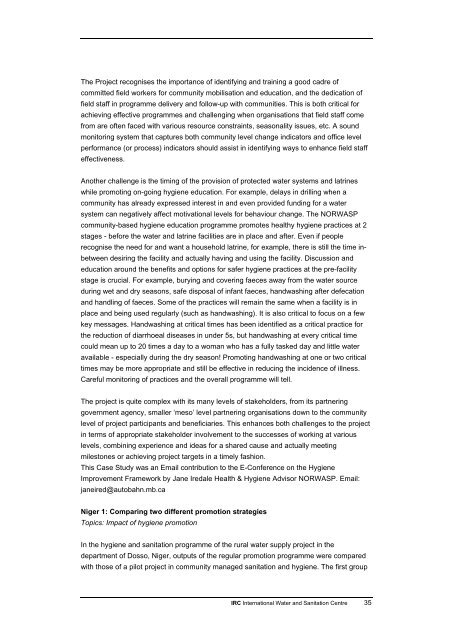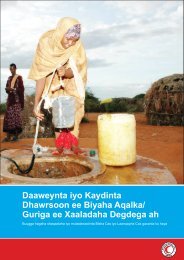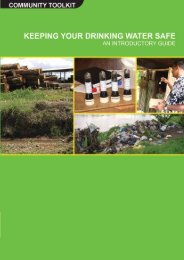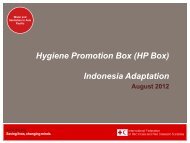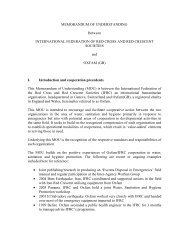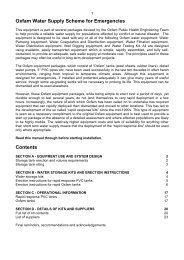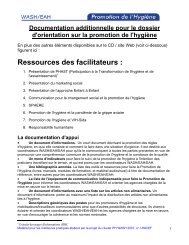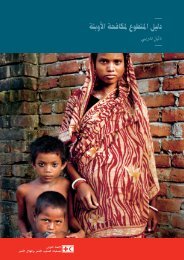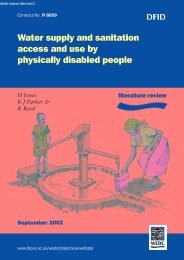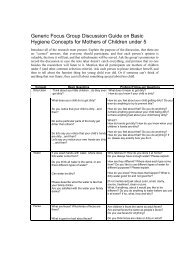Hygiene Promotion - IRC International Water and Sanitation Centre
Hygiene Promotion - IRC International Water and Sanitation Centre
Hygiene Promotion - IRC International Water and Sanitation Centre
You also want an ePaper? Increase the reach of your titles
YUMPU automatically turns print PDFs into web optimized ePapers that Google loves.
The Project recognises the importance of identifying <strong>and</strong> training a good cadre ofcommitted field workers for community mobilisation <strong>and</strong> education, <strong>and</strong> the dedication offield staff in programme delivery <strong>and</strong> follow-up with communities. This is both critical forachieving effective programmes <strong>and</strong> challenging when organisations that field staff comefrom are often faced with various resource constraints, seasonality issues, etc. A soundmonitoring system that captures both community level change indicators <strong>and</strong> office levelperformance (or process) indicators should assist in identifying ways to enhance field staffeffectiveness.Another challenge is the timing of the provision of protected water systems <strong>and</strong> latrineswhile promoting on-going hygiene education. For example, delays in drilling when acommunity has already expressed interest in <strong>and</strong> even provided funding for a watersystem can negatively affect motivational levels for behaviour change. The NORWASPcommunity-based hygiene education programme promotes healthy hygiene practices at 2stages - before the water <strong>and</strong> latrine facilities are in place <strong>and</strong> after. Even if peoplerecognise the need for <strong>and</strong> want a household latrine, for example, there is still the time inbetweendesiring the facility <strong>and</strong> actually having <strong>and</strong> using the facility. Discussion <strong>and</strong>education around the benefits <strong>and</strong> options for safer hygiene practices at the pre-facilitystage is crucial. For example, burying <strong>and</strong> covering faeces away from the water sourceduring wet <strong>and</strong> dry seasons, safe disposal of infant faeces, h<strong>and</strong>washing after defecation<strong>and</strong> h<strong>and</strong>ling of faeces. Some of the practices will remain the same when a facility is inplace <strong>and</strong> being used regularly (such as h<strong>and</strong>washing). It is also critical to focus on a fewkey messages. H<strong>and</strong>washing at critical times has been identified as a critical practice forthe reduction of diarrhoeal diseases in under 5s, but h<strong>and</strong>washing at every critical timecould mean up to 20 times a day to a woman who has a fully tasked day <strong>and</strong> little wateravailable - especially during the dry season! Promoting h<strong>and</strong>washing at one or two criticaltimes may be more appropriate <strong>and</strong> still be effective in reducing the incidence of illness.Careful monitoring of practices <strong>and</strong> the overall programme will tell.The project is quite complex with its many levels of stakeholders, from its partneringgovernment agency, smaller ‘meso’ level partnering organisations down to the communitylevel of project participants <strong>and</strong> beneficiaries. This enhances both challenges to the projectin terms of appropriate stakeholder involvement to the successes of working at variouslevels, combining experience <strong>and</strong> ideas for a shared cause <strong>and</strong> actually meetingmilestones or achieving project targets in a timely fashion.This Case Study was an Email contribution to the E-Conference on the <strong>Hygiene</strong>Improvement Framework by Jane Iredale Health & <strong>Hygiene</strong> Advisor NORWASP. Email:janeired@autobahn.mb.caNiger 1: Comparing two different promotion strategiesTopics: Impact of hygiene promotionIn the hygiene <strong>and</strong> sanitation programme of the rural water supply project in thedepartment of Dosso, Niger, outputs of the regular promotion programme were comparedwith those of a pilot project in community managed sanitation <strong>and</strong> hygiene. The first group<strong>IRC</strong> <strong>International</strong> <strong>Water</strong> <strong>and</strong> <strong>Sanitation</strong> <strong>Centre</strong> 35


